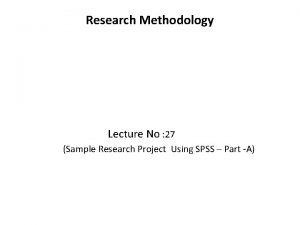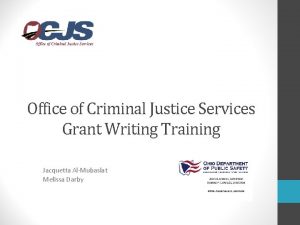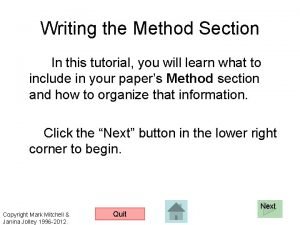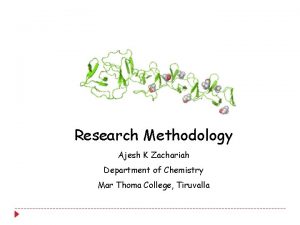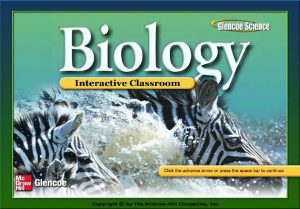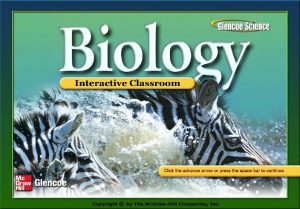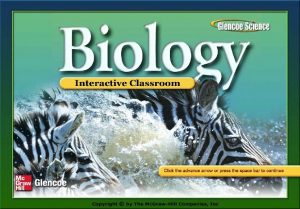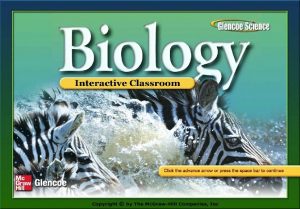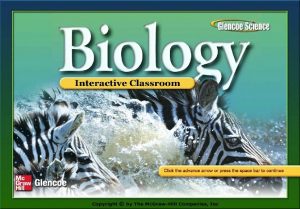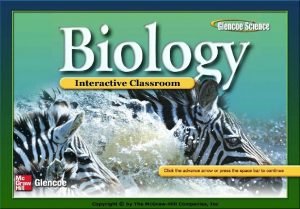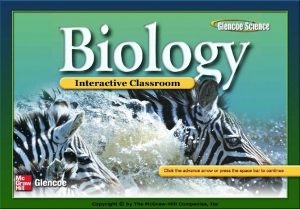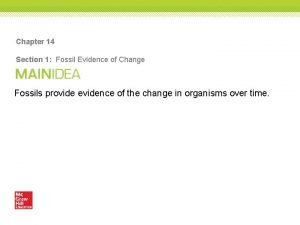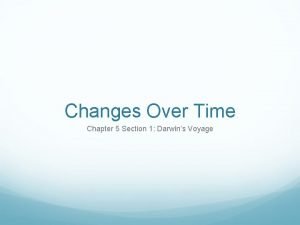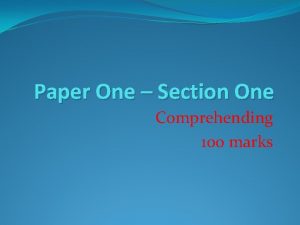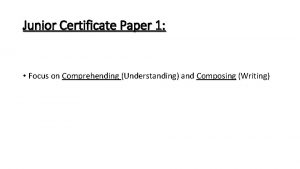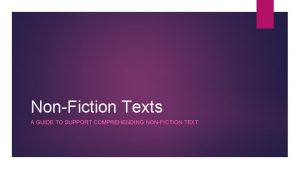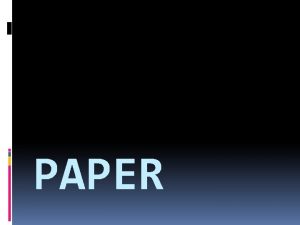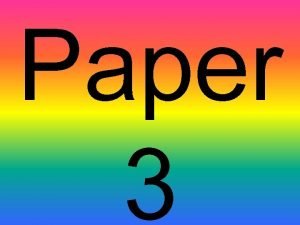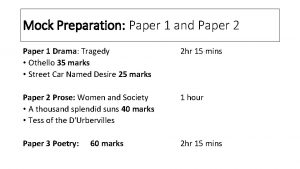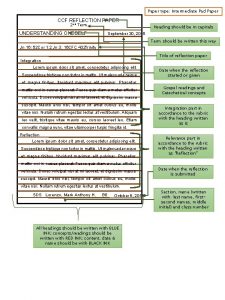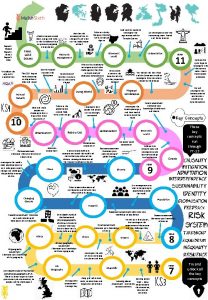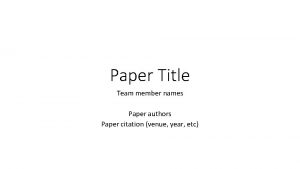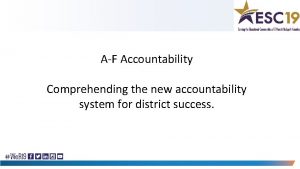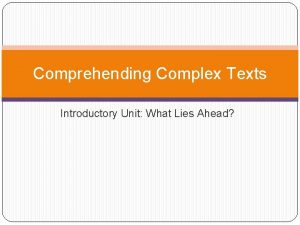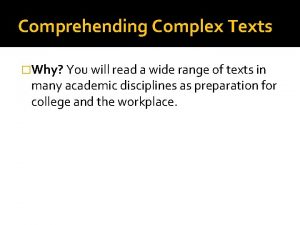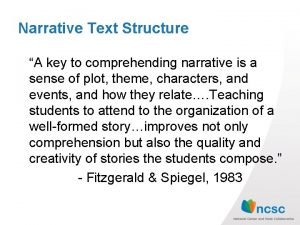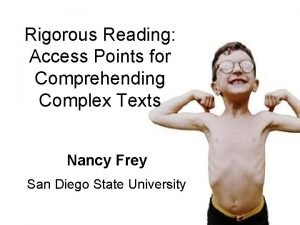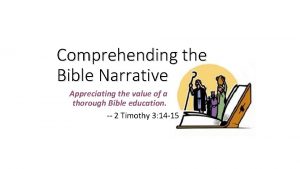Comprehending Paper 1 Section 1 A guide The




























































- Slides: 60

Comprehending: Paper 1, Section 1 A guide

The Theme of the paper • • • Irishness (2001) Family (2002) Journeys (2003) Work and Play (2004) Ordinary Lives (2005) Pretence (2006) Change (2007) Identity (2008) Decisions (2009)

How to answer the exam questions 1. Read the questions first, before reading the passage. – Read the passage with a question in mind 2. Study the title of the piece and any writing in bold underneath the title in order to extract as much information as you can before reading the passage.

3. Sometime the questions can give you a clue about the style of the passage or even its content. 4. Scan the layout of the passage quickly in order to grasp its central message. – Sometimes sub headings will give you some idea about the content.

5. Keep the questions in mind as you read. Read the passage as often as you need in order to find the answers. 6. Do not worry about words that you may not understand. Try to guess the meaning from the content. 7. Always make sure that you are answering the question asked. 8. Study the vocabulary needed for Comprehension answers and learn how to use these terms. 9. Learn the features of style for each of the Language Genres.

10. When reading the passage, jot down all the ideas that come to you regarding the question or simply mark the areas in the text that are relevant. – Take particular note of key quotations that you can use in your answer. 11. Take account of every part of the question – Sometimes questions can be divided into two or even three different parts. – You must answer every part clearly. 12. Keep a close eye on your timing and stop writing when your allotted time is up.

13. Use your own words as much as possible and keep making reference to the passage to support your points. 14. Check that you have answered the question clearly in several coherent paragraphs. – Have you used material from the texts to support your answer? – Is your answer clear? – Is it logical? – Is it written in the correct language register?

Key Point In the Comprehending section your answers must be: • Clear • Logical • Factual • Precise • Simple, not ambiguous or awkward

Features of a good Comprehension answer 1. Answers reflect a clear understanding of the content of the passage. 2. Organise your thoughts clearly and focus on exactly what you are being asked so that you can structure a clear answer. – In this way you will avoid padding or introducing irrelevant points. A good answer is written clearly and coherently.

3. You must display a thorough grasp of the writer’s purpose in writing. – Try to work out the style in which the passage is written: is it persuasive writing or argument writing or narrative writing? – Be sure to refer to this in your answer 4. You must display an ability to follow a line of argument and to evaluate the points objectively. 5. Your answers must show that you can master the basic elements of writing, e. g. How to construct paragraphs and how to introduce references or quotations from the passage.

6. You will also need to show an ability to ‘read between the lines’ and to discern different tone or voices in the passage. 7. Your answer must use clear, correct English and lucid argument to support your statements.

Common errors 1. Misunderstanding of the content 2. Not giving enough points: points a question with 20 marks needs at least FOUR points in the answer. 3. Misunderstanding the questions. – Distinguish between terms e. g. How, why, demonstrate etc. 4. Not giving reasons for answers when asked to do so.

Common errors 5. Badly structured answers – where the main point is ignored and irrelevant points are introduced and developed. 6. Badly written answers – with faulty grammar, weak expression and poor punctuation. 7. Not answering the question asked – but rambling and going off the point.

Style and structure Style is the ability to present a subject in a way that is best suited to achieving the writer’s aim or purpose. – Remember: every writer has a purpose to their writing. – Your job is to identify that purpose when looking at Comprehension passages.

Style and structure: elements Tone and mood • Read between the lines • Understand how language and imagery work together to create a certain tone or mood and how they all add up to a coherent style.

Tone (an author’s attitude) Tone is the relationship a writer establishes with the reader – how the writer is saying what is in the passage.

Tone The reflection in a work of the author’s attitude toward his or her subject, characters, and readers. humorous condescending grim apologetic nostalgic playful tender -- serious brusque -- ironic Listening to Characters

What tone? • Keep off the grass • Please use footpaths • Don’t steal things from our hotel or we’ll have you arrested • Please leave all hotel belongings in the room. Thank you! • No trucks in left lane • Trucks use two right hand lanes

This poster was found in a hotel. Mistakes: • Grammar • Spelling It also uses an inappropriate tone. Rewrite this poster using an appropriate tone.

Mood (a reader’s reaction) Mood is the atmosphere of the piece of writing. • Tends to relate to fiction writing • Gives a feeling of the world

• Listen to the song for thirty seconds • Picture a scene

Task Rules • The music will play for four minutes • As the music plays write the description that you just started seeing • Present tense • Do not include the dialogue Describe: • Place • Time • People • and their actions The music will be playing in the background

Peer reading • Swap and read silently without editing • Write one word to describe the tone/attitude at the top of your partners work • Is it the tone/attitude you intended? • Swap the copies again partner will now underline words/phrases that conveyed that tone • If someone is using figurative language let them know that’s what worked for you

Peer reading • Swap and read silently without editing • Highlight/circle the words that created the mood. • Write one word to describe the mood of your partners work at the top of the page. • Is it the mood you intended?

Exam Focus Do you remember the way in which all of your exam questions are graded? • • Clarity of purpose Coherence of delivery Efficiency of language use Accuracy of mechanics Apply these to each paragraph

Structure The structure is the layout of the writing, i. e. Whether it is written as one continuous piece of prose or structured in paragraphs. A comprehension is made up of: (a) paragraphs; (b) Sentences; (c) Words.

Paragraphs In each paragraph you should be aware of: • Topic sentence • Support for the topic sentence • Language used in the sentences of the paragraph • Mechanics There should be coherence, or a link, both within and between paragraphs: • Linking words • Asking a question in one and answering it in another.

Sentences “A group of words that makes sense. ” • The way in which a writer constructs sentences can reveal certain attitudes they may have towards their subject matter. • A writer can speed up the flow of writing by creating a series of short, terse, rapid sentences.

Sentences may be classified according to their: • Purpose; • Syntax (the particular order of words in a sentence); • Form.

Sentences: Purpose 1. 2. 3. 4. Declarative – a statement or an assertion Interrogative – asking a question Imperative – giving a command Exclamatory – expressing surprise or shock

1. I wish I could go to America this summer. _____ 2. Please set the table for lunch. _____ 3. The vice-president will visit Egypt next week. _____ 4. Don't you ever get tired of watching television? _____ 5. We bought our car in April, 1975. _____ 6. Didn't I meet you at Electric picnic last summer? _____ 7. Have you ever roasted a turkey? _____ 8. Ouch! I burned my finger! _____ 9. Turn left at the second stop sign. _____ 10. San Marino is the smallest republic in Europe. _____ 11. Initial the top right-hand corner of each sheet of paper. _____ 12. Richard Martin's short stories have appeared in many magazines. _____ 13. Have you ever read The Red Badge of Courage? _____ 14. You can't be serious! _____ 15. Meet me at seven o'clock in front of the library. _____ 16. Why are you so worried about the exam? _____ 17. Don't close your mind to the other side of the question. _____ 18. Nancy wants to be a doctor. _____ 19. I can't believe it's all over! _____ 20. Do you attend concerts given by the RTE Symphony Orchestra? _____

Sentences: Syntax 1. Simple – made up of one subject or one object 2. Compound – two simple sentences connected by a conjunction 3. Complex – a statement followed by one or two qualifying clauses

Simple, compound and complex sentences Learning challenges: ü To understand the difference between a simple, compound and complex sentence ü To be able to identify these sentence structures in a text ü To be able to use different types of sentence structures in writing Ø Key word – clause meaning a part or section

Simple, compound and complex sentences Learning challenges: ü To understand the difference between a simple, compound and complex sentence ü To be able to identify these sentence structures in a text ü To be able to use different types of sentence structures in writing Ø Key word – clause meaning a part or section

• http: //www. youtube. com/watch? v=Sjrq 3 MOc MFM

Simple sentence • A sentence that has two or more clauses, joined by a conjunction Compound sentence • A sentence that is made up of one main clause and one dependent clause Complex sentence • A sentence that contains one independent clause

Simple sentence • A sentence that has two or more clauses, joined by a conjunction Compound sentence • A sentence that is made up of one main clause and one dependent clause Complex sentence • A sentence that contains one independent clause

Simple sentence Complex sentence Which is which? 1. The dog barked. 2. I go to the Gateway Academy and I am in Year 11. 3. The girl in the library choose a book. 4. The boy waited for his friends, sitting on the playing field. 5. The man roared fiercely and scared the young baby. 6. I really want to be a pop star when I’m older, a famous one. 7. There were three girls standing in the corner. 8. The teacher banged on the wall but he couldn’t be heard in the next room. 9. I have a huge collection of shoes, all sorts and colours. Compound sentence

üTo understand the difference between a simple, compound and complex sentence TASK 1. In your books write a definition for each type of sentence – simple, compound and complex. 2. Create an example of a simple sentence. 3. Extend it into a compound sentence. 4. Then amend it so it becomes a complex sentence.

üTo understand the difference between a simple, compound and ! complex sentence t c TASK w s n s r e c e ar e r or a s ’ r 1. In your books write a definition for each type of e h t o sentence – simple, compound and complex. ch a e of a simple sentence. 2. Create an example k c e h a compound sentence. 3. Extend it into C. s k o 4. Thenbamend it so it becomes a complex sentence. o p a Sw

What types of sentences do Daz and Zoe use? SIMPLE COMPOUND COMPLEX Ned began making his way towards the bar and the rest of us followed. The Chippies let us through, but they weren’t acting pleased to see us and I avoided looking in their eyes. When we all had drinks, Ned used his height to look for space. He spotted some and we went and stood there, holding our drinks and surveying the scene. Thay come in lucking nervous. 4 of em. 2 guys 2 wumen, nor thay aint old enuff 2 be owt ov school neever. Stop by the door lucking rownd like somfing smell bad. i’m wiv Mick and som ovver guys and we just turn away like we saying you noffing 2 us you Subby trash. only thers 1 of em rite. this girl and she’s nice.

What types of sentences do Daz and Zoe use? SIMPLE COMPOUND COMPLEX Ned began making his way towards the bar and the rest of us followed. The Chippies let us through, but they weren’t acting pleased ? s r e to see us and I avoided looking in their eyes. t c ra He When we all had drinks, Ned used his height to look for a space. chdrinks and spotted some and we went and stood there, holdingsour a surveying the scene. m u o b a s u e h t t l 4 of em. 2 guys 2 wumen, nor l Thay come in lucking nervous. e t s i thay aint old enufft 2 be owt ov school neever. Stop by the h es like somfing smell bad. i’m wiv Mick and door lucking rownd o t d and we just turn away like we saying you som ovveraguys h W 2 us you Subby trash. only thers 1 of em rite. this girl noffing ? hyshe’s nice. and W

Sentence structure Use this picture as inspiration! Write a paragraph describing what you see and/or what you think is happening in the scene.

Sentence structure Use a mixture of simple, compound and complex sentences. Use this picture as inspiration! Write a paragraph describing what you see and/or what you think is happening in the scene.

Sentences: Form 1. Periodic – with the main idea coming at the end 2. Loose – with the main point coming at the beginning 3. Balanced – having a similarity of thought and a similarity of structure 4. Inverted – with the subject of the sentence coming in the middle or at the end 5. Antithetical – creating antithesis, which could be described as similar to a balanced sentence, but with the balance created by opposing ideas

Words 1. Pictorial words – draw an image or picture of something 2. Concrete words – give a specific idea about something 3. Abstract words – are the opposite of concrete words. It means something that is not specific or tangible.

Context of Words Examine the context of certain words. Both the context and connotations of words can affect the writer’s message or purpose. The same word or set of words can be used to provoke a totally different type of reaction in the reader, depending on its context.

Connotations of words The connotation of a word is the emotive impact it may have on a reader. It is the association, whether positive or negative, that the word conjures up in the mind. Word connotations all suggest certain attitudes towards an idea

Word Home Young Traditional Soap opera White Snake Raw Connotation

Word Connotation Home Comfort, safety, love Young Naive, energetic, fresh Traditional Conservative, old, historic Soap opera Trivial, tear-jerker White Purity, cleanliness, innocence, peace Snake Dangerous, sly, evil Raw Rough, uncouth, unfinished

Words: Syntax can be defined a the order of words a writer uses when constructing sentences. The syntax can play a large part in the communication of certain ideas to the reader in controlling or manipulating the reader’s responses.

Imagery When you see imagery in Comprehension pieces or writing, ask yourself the following questions: • Why is it used in the passage? • What is it actually saying? • Does it have connotations or sound effects? • Does the imagery contribute to the passage by conveying the ideas well?

Imagery: Reasons 1. To illustrate a point 2. To create atmosphere 3. To provoke an emotional reaction

Imagery: Types 1. 2. 3. 4. 5. Simple Original Vivid/clear Exotic Startling

Exam Focus In Comprehension, a good student must be able to ask and answer the following questions 1. What was the writer’s intention in writing this passage? 2. Who is the intended audience for this passage? Are the techniques used suitable for this audience. Explain why or why not. 3. Is the writing structured clearly in paragraphs, and if so, does each paragraph fit into the scheme of the writing as a whole?

Exam Focus 4. Is the writer appealing to our emotions or to our intellect? Why is this so? 5. Does the nature of the subject justify the use of the emotions employed? 6. If the writing is based on argument, do you find the arguments convincing? If so, why? 7. Is the style uniform or does it vary? If so, why is this? Does the style suit the subject or is it too dull or too ornate? 8. What do the style and subject matter tell us about the writer? 9. Look at the writer’s choice of words: are they relevant, excessive, appropriate, precise etc. ?

Vocabulary used in the questions Analyse Compare Contrast Criticise Define Discuss Disprove Evaluate

Vocabulary used in the questions Explain Illustrate Justify Prove State Summarise/Out line Trace

Vocabulary used in the questions Analyse To take apart an idea or a statement in order to consider all of its aspects. Compare To show the similarities or the differences between things. Contrast To show the differences between things. Criticise To point out mistakes and weaknesses in a balanced way. Define To give the precise meaning of a concept. Discuss To explain a passage and give details, with examples. Disprove To produce arguments that show something to be false. Evaluate To discuss, and then to go on to judge, for and against.

Vocabulary used in the questions Explain To offer a detailed and exact explanation of an idea or principle. Illustrate To give examples that demonstrate or prove a point. Justify To give reasons for holding a particular position or viewpoint. Prove To give answer that demonstrate the logical position. State To express the points briefly and clearly. Summarise/Out To give only the main points – not details. line Trace To give a description, in logical or chronological order, of the stages of a process.
 Paper 2 aice general paper
Paper 2 aice general paper Aice general paper 1 example essay
Aice general paper 1 example essay Hình ảnh bộ gõ cơ thể búng tay
Hình ảnh bộ gõ cơ thể búng tay Frameset trong html5
Frameset trong html5 Bổ thể
Bổ thể Tỉ lệ cơ thể trẻ em
Tỉ lệ cơ thể trẻ em Gấu đi như thế nào
Gấu đi như thế nào Chụp tư thế worms-breton
Chụp tư thế worms-breton Hát lên người ơi
Hát lên người ơi Môn thể thao bắt đầu bằng chữ đua
Môn thể thao bắt đầu bằng chữ đua Thế nào là hệ số cao nhất
Thế nào là hệ số cao nhất Các châu lục và đại dương trên thế giới
Các châu lục và đại dương trên thế giới Công thức tính thế năng
Công thức tính thế năng Trời xanh đây là của chúng ta thể thơ
Trời xanh đây là của chúng ta thể thơ Mật thư tọa độ 5x5
Mật thư tọa độ 5x5 101012 bằng
101012 bằng Phản ứng thế ankan
Phản ứng thế ankan Các châu lục và đại dương trên thế giới
Các châu lục và đại dương trên thế giới Thể thơ truyền thống
Thể thơ truyền thống Quá trình desamine hóa có thể tạo ra
Quá trình desamine hóa có thể tạo ra Một số thể thơ truyền thống
Một số thể thơ truyền thống Cái miệng nó xinh thế
Cái miệng nó xinh thế Vẽ hình chiếu vuông góc của vật thể sau
Vẽ hình chiếu vuông góc của vật thể sau Biện pháp chống mỏi cơ
Biện pháp chống mỏi cơ đặc điểm cơ thể của người tối cổ
đặc điểm cơ thể của người tối cổ Thế nào là giọng cùng tên
Thế nào là giọng cùng tên Vẽ hình chiếu đứng bằng cạnh của vật thể
Vẽ hình chiếu đứng bằng cạnh của vật thể Tia chieu sa te
Tia chieu sa te Thẻ vin
Thẻ vin đại từ thay thế
đại từ thay thế điện thế nghỉ
điện thế nghỉ Tư thế ngồi viết
Tư thế ngồi viết Diễn thế sinh thái là
Diễn thế sinh thái là Dot
Dot Số nguyên tố là gì
Số nguyên tố là gì Tư thế ngồi viết
Tư thế ngồi viết Lời thề hippocrates
Lời thề hippocrates Thiếu nhi thế giới liên hoan
Thiếu nhi thế giới liên hoan ưu thế lai là gì
ưu thế lai là gì Hươu thường đẻ mỗi lứa mấy con
Hươu thường đẻ mỗi lứa mấy con Khi nào hổ con có thể sống độc lập
Khi nào hổ con có thể sống độc lập Sơ đồ cơ thể người
Sơ đồ cơ thể người Từ ngữ thể hiện lòng nhân hậu
Từ ngữ thể hiện lòng nhân hậu Thế nào là mạng điện lắp đặt kiểu nổi
Thế nào là mạng điện lắp đặt kiểu nổi Methodology sample for project
Methodology sample for project Ohio office of criminal justice services
Ohio office of criminal justice services Example of participants section in research paper
Example of participants section in research paper Example of methodology section of research paper
Example of methodology section of research paper Section 17-3 note taking guide answer key
Section 17-3 note taking guide answer key Study guide chapter 3 section 1 community ecology
Study guide chapter 3 section 1 community ecology Study guide chapter 5 section 1 biodiversity
Study guide chapter 5 section 1 biodiversity Chapter 4 section 1 population dynamics study guide answers
Chapter 4 section 1 population dynamics study guide answers Chapter 35 section 1 the digestive system
Chapter 35 section 1 the digestive system Chapter 31 section 1 basic behaviors study guide answer key
Chapter 31 section 1 basic behaviors study guide answer key Chapter 29 reptiles and birds worksheet answer key
Chapter 29 reptiles and birds worksheet answer key Chapter 28 fishes and amphibians answer key
Chapter 28 fishes and amphibians answer key Study guide chapter 18 section 1 bacteria
Study guide chapter 18 section 1 bacteria Chapter 16 primate evolution assessment answer key
Chapter 16 primate evolution assessment answer key Chapter 14 study guide section 1 fossil evidence of change
Chapter 14 study guide section 1 fossil evidence of change Population ecology section 1 population dynamics answer key
Population ecology section 1 population dynamics answer key Adaptation
Adaptation












































